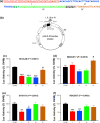Identification of an intronic cis-acting element in the human dopamine transporter gene
- PMID: 22160470
- PMCID: PMC5332114
- DOI: 10.1007/s11033-011-1339-4
Identification of an intronic cis-acting element in the human dopamine transporter gene
Abstract
The human dopamine transporter gene (hDAT) encodes the dopamine transporter in dopamine (DA) neurons to regulate DA transmission. hDAT expression varies significantly from neuron to neuron, and from individual to individual so that dysregulation of hDAT is related to many neuropsychiatric disorders. It is critical to identify hDAT-specific cis-acting elements that regulate the hDAT expression. Previous studies showed that hDAT Intron 1 displayed inhibitory activity for reporter gene expression. Here we report that the hDAT Intron 1 contains a 121-bp fragment that down-regulated both SV40 and hDAT promoter activities by 80% in vitro. Subfragments of 121-bp still down-regulated the SV40 promoter but not the hDAT promoter, as supported by nuclear protein-binding activities. Collectively, 121-bp is a silencer in vitro that might coordinate with transcriptional activities both inside and outside 121-bp in regulation of hDAT.
Figures





Similar articles
-
The correlation between DNA methylation and transcriptional expression of human dopamine transporter in cell lines.Neurosci Lett. 2018 Jan 1;662:91-97. doi: 10.1016/j.neulet.2017.10.013. Epub 2017 Oct 10. Neurosci Lett. 2018. PMID: 29030220
-
Raman Spectroscopic Signature Markers of Dopamine-Human Dopamine Transporter Interaction in Living Cells.ACS Chem Neurosci. 2017 Jul 19;8(7):1510-1518. doi: 10.1021/acschemneuro.7b00048. Epub 2017 Apr 21. ACS Chem Neurosci. 2017. PMID: 28375605
-
Identifying dominant-negative actions of a dopamine transporter variant in patients with parkinsonism and neuropsychiatric disease.JCI Insight. 2021 Sep 22;6(18):e151496. doi: 10.1172/jci.insight.151496. JCI Insight. 2021. PMID: 34375312 Free PMC article.
-
Molecular mechanism: the human dopamine transporter histidine 547 regulates basal and HIV-1 Tat protein-inhibited dopamine transport.Sci Rep. 2016 Dec 14;6:39048. doi: 10.1038/srep39048. Sci Rep. 2016. PMID: 27966610 Free PMC article.
-
The role of human dopamine transporter in NeuroAIDS.Pharmacol Ther. 2018 Mar;183:78-89. doi: 10.1016/j.pharmthera.2017.10.007. Epub 2017 Oct 5. Pharmacol Ther. 2018. PMID: 28987321 Free PMC article. Review.
Cited by
-
Identification of HIVEP2 as a dopaminergic transcription factor related to substance use disorders in rats and humans.Transl Psychiatry. 2019 Oct 4;9(1):247. doi: 10.1038/s41398-019-0573-8. Transl Psychiatry. 2019. PMID: 31586043 Free PMC article.
-
Association of SLC6A3 variants with treatment-resistant schizophrenia: a genetic association study of dopamine-related genes in schizophrenia.Front Psychiatry. 2024 Feb 27;14:1334335. doi: 10.3389/fpsyt.2023.1334335. eCollection 2023. Front Psychiatry. 2024. PMID: 38476817 Free PMC article.
-
Human dopamine transporter gene: differential regulation of 18-kb haplotypes.Pharmacogenomics. 2013 Sep;14(12):1481-94. doi: 10.2217/pgs.13.141. Pharmacogenomics. 2013. PMID: 24024899 Free PMC article.
-
AZI23'UTR Is a New SLC6A3 Downregulator Associated with an Epistatic Protection Against Substance Use Disorders.Mol Neurobiol. 2018 Jul;55(7):5611-5622. doi: 10.1007/s12035-017-0781-2. Epub 2017 Oct 5. Mol Neurobiol. 2018. PMID: 28983843 Free PMC article.
-
hVMAT2: A Target of Individualized Medication for Parkinson's Disease.Neurotherapeutics. 2016 Jul;13(3):623-34. doi: 10.1007/s13311-016-0435-5. Neurotherapeutics. 2016. PMID: 27137201 Free PMC article.
References
-
- Hitri A, Hurd YL, Wyatt RJ, Deutsch SI. Molecular, functional and biochemical characteristics of the dopamine transporter: regional differences and clinical relevance. Clin Neuropharmacol. 1994;17:1–22. - PubMed
-
- Ohyama K, Sogawa C, Sogawa N, Morita K, Dohi T, Kitayama S. Nicotine stimulates transcriptional activity of the human dopamine transporter gene. Neurosci Lett. 2010;471:34–37. - PubMed
-
- Stevens SE, Kumsta R, Kreppner JM, Brookes KJ, Rutter M, Sonuga-Barke EJ. Dopamine transporter gene polymorphism moderates the effects of severe deprivation on ADHD symptoms: developmental continuities in gene–environment interplay. Am J Med Genet B. 2009;150B:753–761. - PubMed
-
- Bannon MJ, Whitty CJ. Age-related and regional differences in dopamine transporter mRNA expression in human midbrain. Neurology. 1997;48:969–977. - PubMed
Publication types
MeSH terms
Substances
Grants and funding
LinkOut - more resources
Full Text Sources

